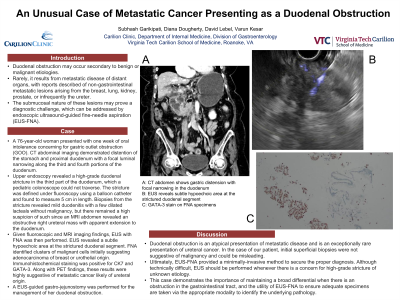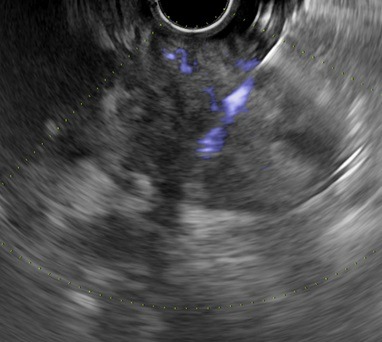Monday Poster Session
Category: Small Intestine
P2653 - An Unusual Case of Metastatic Cancer Presenting as a Duodenal Obstruction
Monday, October 23, 2023
10:30 AM - 4:15 PM PT
Location: Exhibit Hall

Has Audio
- SG
Subhash Garikipati, MD
Carilion Clinic Virginia Tech
Roanoke, VA
Presenting Author(s)
Award: Presidential Poster Award
Subhash Garikipati, MD, Diana Dougherty, MD, David Lebel, MD, Varun Kesar, MD
Carilion Clinic Virginia Tech, Roanoke, VA
Introduction: Duodenal obstruction may occur secondary to benign or malignant etiologies. Rarely, it results from metastatic disease of distant organs, with reports described of non-gastrointestinal metastatic lesions arising from the breast, lung, kidney, prostate, or infrequently the ureter. The submucosal nature of these lesions may prove a diagnostic challenge, which can be addressed by endoscopic ultrasound-guided fine-needle aspiration (EUS-FNA).
Case Description/Methods: A 76-year-old woman presented with one week of oral intolerance concerning for gastric outlet obstruction (GOO). CT abdominal imaging demonstrated distention of the stomach and proximal duodenum with a focal luminal narrowing along the third and fourth portions of the duodenum. Upper endoscopy revealed a high-grade duodenal stricture in the third part of the duodenum, which a pediatric colonoscope could not traverse. The stricture was defined under fluoroscopy using a balloon catheter and found to measure 5 cm in length. Biopsies from the stricture revealed mild duodenitis with a few dilated lacteals without malignancy, but there remained a high suspicion of such since an MRI abdomen revealed an obstructive right ureteral mass with apparent extension to the duodenum. Given fluoroscopic and MRI imaging findings, EUS with FNA was then performed. EUS revealed a subtle hypoechoic area at the strictured duodenal segment. FNA identified clusters of malignant cells initially suggesting adenocarcinoma of breast or urothelial origin. Immunohistochemical staining was positive for CK7 and GATA-3. Along with PET findings, these results were highly suggestive of metastatic cancer likely of ureteral origin. A EUS-guided gastro-jejunostomy was performed for the management of her duodenal obstruction.
Discussion: Duodenal obstruction is an atypical presentation of metastatic disease and is an exceptionally rare presentation of ureteral cancer. In the case of our patient, initial superficial biopsies were not suggestive of malignancy and could be misleading. Ultimately, EUS-FNA provided a minimally-invasive method to secure the proper diagnosis. Although technically difficult, EUS should be performed whenever there is a concern for high-grade stricture of unknown etiology. This case demonstrates the importance of maintaining a broad differential when there is an obstruction in the gastrointestinal tract, and the utility of EUS-FNA to ensure adequate specimens are taken via the appropriate modality to identify the underlying pathology.

Disclosures:
Subhash Garikipati, MD, Diana Dougherty, MD, David Lebel, MD, Varun Kesar, MD. P2653 - An Unusual Case of Metastatic Cancer Presenting as a Duodenal Obstruction, ACG 2023 Annual Scientific Meeting Abstracts. Vancouver, BC, Canada: American College of Gastroenterology.
Subhash Garikipati, MD, Diana Dougherty, MD, David Lebel, MD, Varun Kesar, MD
Carilion Clinic Virginia Tech, Roanoke, VA
Introduction: Duodenal obstruction may occur secondary to benign or malignant etiologies. Rarely, it results from metastatic disease of distant organs, with reports described of non-gastrointestinal metastatic lesions arising from the breast, lung, kidney, prostate, or infrequently the ureter. The submucosal nature of these lesions may prove a diagnostic challenge, which can be addressed by endoscopic ultrasound-guided fine-needle aspiration (EUS-FNA).
Case Description/Methods: A 76-year-old woman presented with one week of oral intolerance concerning for gastric outlet obstruction (GOO). CT abdominal imaging demonstrated distention of the stomach and proximal duodenum with a focal luminal narrowing along the third and fourth portions of the duodenum. Upper endoscopy revealed a high-grade duodenal stricture in the third part of the duodenum, which a pediatric colonoscope could not traverse. The stricture was defined under fluoroscopy using a balloon catheter and found to measure 5 cm in length. Biopsies from the stricture revealed mild duodenitis with a few dilated lacteals without malignancy, but there remained a high suspicion of such since an MRI abdomen revealed an obstructive right ureteral mass with apparent extension to the duodenum. Given fluoroscopic and MRI imaging findings, EUS with FNA was then performed. EUS revealed a subtle hypoechoic area at the strictured duodenal segment. FNA identified clusters of malignant cells initially suggesting adenocarcinoma of breast or urothelial origin. Immunohistochemical staining was positive for CK7 and GATA-3. Along with PET findings, these results were highly suggestive of metastatic cancer likely of ureteral origin. A EUS-guided gastro-jejunostomy was performed for the management of her duodenal obstruction.
Discussion: Duodenal obstruction is an atypical presentation of metastatic disease and is an exceptionally rare presentation of ureteral cancer. In the case of our patient, initial superficial biopsies were not suggestive of malignancy and could be misleading. Ultimately, EUS-FNA provided a minimally-invasive method to secure the proper diagnosis. Although technically difficult, EUS should be performed whenever there is a concern for high-grade stricture of unknown etiology. This case demonstrates the importance of maintaining a broad differential when there is an obstruction in the gastrointestinal tract, and the utility of EUS-FNA to ensure adequate specimens are taken via the appropriate modality to identify the underlying pathology.

Figure: EUS reveals subtle hypoechoic area at the strictured duodenal segment
Disclosures:
Subhash Garikipati indicated no relevant financial relationships.
Diana Dougherty indicated no relevant financial relationships.
David Lebel indicated no relevant financial relationships.
Varun Kesar indicated no relevant financial relationships.
Subhash Garikipati, MD, Diana Dougherty, MD, David Lebel, MD, Varun Kesar, MD. P2653 - An Unusual Case of Metastatic Cancer Presenting as a Duodenal Obstruction, ACG 2023 Annual Scientific Meeting Abstracts. Vancouver, BC, Canada: American College of Gastroenterology.

